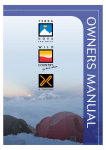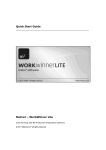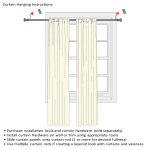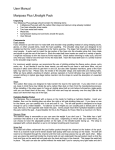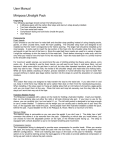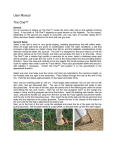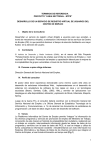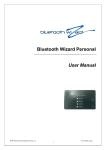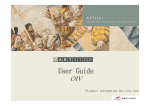Download OWNERS MANUAL
Transcript
OWNERS MANUAL Thank you for buying one of our outdoor products, and we hope you have many happy adventures with it. To help with this, we have provided you with this Owners Manual, with advice on the use and care of the products in our range. Contents TENTS 1 General pitching advice 2Condensation management 3Fabrics 4Fire and ventilation precautions 5Seams 6 UV light degradation 7Poles 8 Which eyelet do I use? 9Zips 10 Extended use 11Storage 12Servicing 13Cleaning 14Repairs 15Spares 16Accessories RUCKSACKS 1 Tents General pitching advice Practice pitching your tent before using it for the first time. Clear the site of stones and twigs and if possible use a Groundsheet Protector (GSP) or Footprint. Groundsheet Protectors (purchased separately) or ‘footprints’ provide extra protection from sharp objects and rough ground, and help prolong the life of the tent’s groundsheet. Groundsheet Protectors are cut precisely to fit under the inner tent(s) of each model whereas Footprints cover the complete Footprint of the tent. It is not advisable to wear boots inside the tent. Try to ensure that nothing sharp or abrasive is pushed against the groundsheet inside the tent. Pitch the tent with the back into wind and use natural shelter (hedges, walls etc) where possible. Choose a level, sheltered site that is well drained. Sap is almost impossible to remove from flysheet fabric, so avoid pitching under trees. 1Storage 2Cleaning Always ensure that everything is pegged or weighted down, including the flysheet awaiting assembly. SLEEPING BAGS Once pitched leave the doors closed as much as possible since they increase the strength and stability of the tent. Never leave the doors open if you are away from the tent, particularly on windy days. 1Storage 2Cleaning EXTREMITIES 1Cleaning GUARANTEE CONTACT US If you have to pitch an inner-first model in the rain, we would advise covering the pegged down inner with the flysheet whilst you thread the poles. If conditions prevent this, the speed with which you can pitch a Terra Nova tent (with practice) will minimise the exposure of the inner to the rain. Inner tents have a DWR treatment to enable any water that reaches the inner tent to bead and roll away. We provide the minimum amount of pegs and guy lines with each of our tents to match the intended use. But check that you have the correct type of peg and quantity of guy ropes to match your intended circumstance of use. You can purchase a wide range of extra pegs, guy lines and accessories at www.terra-nova.co.uk Always use all the guylines on the flysheet. Guylines contribute to the overall strength of the tent, increasing its stability and performance in bad weather. Failure to use guylines correctly may result in damage to the tent. Make sure you are using the peg correctly to get maximum advantage, the best angle is approximately 45 degrees, with the hook at the top of the peg facing away from the tent. In extreme circumstances you can use two pegs crossed over to get a more secure anchor point. Where there is loose ground or snow you can fix guy lines to things buried such as rocks or equipment you may have with you such as skis, poles or axes. We also offer ‘Dead guys’ as an anchor system, see our website for details. 2 Condensation management Condensation occurs in all tents. The amount of condensation will vary depending on the prevailing conditions, from water only apparent on touching the inside of the tent to droplets extending over the whole upper canopy. In really heavy rain condensation can be mistaken for leaking as the condensation is bounced off the inside of the flysheet. Single skin tents and bivi bags will suffer more from condensation than conventional tents. For maximum safety and comfort we always recommend the bivi bag zip be left slightly open when in use. Tents fitted with snow valances are also likely to suffer more due to reduced air flow. A person can produce more than one litre of perspiration in a single night, so maximising ventilation is the key to reducing condensation. There are various ventilation systems designed into our tents, you can see product information on our website or if you have any questions please contact your retailer or our sales team. On still, dry nights, leave the flysheet doors and vents open as much as possible. On windy, dry nights, it should be possible to have no condensation at all if the tent is well ventilated, as the action of the wind on the flysheet pumps out the damp air. In freezing conditions condensation can form as hoarfrost inside the tent. Again, prevention by maximum ventilation is the answer. Generally, the best method of dealing with heavy condensation, assuming dry conditions in the morning, is to remove the flysheet, shake off condensation and replace it. If the condensation is slight and conditions are windy, simply venting the tent will soon dry out the flysheet. You can sometimes get a damp section between your sleeping mat and the groundsheet, this does not necessarily mean that the material is leaking it can just be a build up of condensation. 3 4 Fire damage, or associated heat damage, such as cooking fat are not covered by our guarantee. 5 Fabrics During prolonged heavy rain the nylon fibres in the flysheet fabric will absorb some of the water and expand. This will give the flysheet a wet appearance in places – wetting out – and may cause it to sag slightly. If this occurs it is important to retension the flysheet by adjusting the pole feet from the outer most to inner most eyelet on the webbing tapes. After the rain has stopped and the flysheet starts to dry out, the nylon fibres will contract. It is important to loosen the flysheet tension by re adjusting the pole feet to the outer most eyelets on the webbing tapes. If the tension is not released, in some cases, the force of the contracting flysheet can damage the poles. Cleaning and reproofing the outer surface with Terra Nova Tent Cleaner and Tent re-proofer can help stop water from building up in the fibres and causing the effects of wetting out. Fire and ventilation precautions Warning: Our tents are made of fabric that is not flame resistant or fire proof. The fabric will burn if it comes in contact with any flame source. Death by carbon monoxide poisoning and / or serious burns are possible. Our advice therefore is ‘do not cook in our tents or porch areas’. 6 It is also important, at all times, to maintain adequate ventilation in your tent or bivi to avoid suffocation. Seams Some Terra Nova models use Silicon coatings on both faces of the flysheet fabric. In these models it is not possible to factory seam tape the seam. Best efforts are made through design and position of these seams to ensure that water does not leak through these points. To make certain that water does not leak through these seams, we recommend that you apply a seam sealer such as Silnet by Mcnett to the exterior of the seams on these models. If you are unsure to which tent model this relates, please either contact your retailer, check our web site, or give us a call on 01773 837373. UV light degradation Exposure to strong sunlight causes damage to all tent fabrics, resulting in the fabric losing strength. This is normal wear and tear. The lighter fabrics are more susceptible to UV damage. High altitude exposure causes much more rapid degradation. Preventing early deterioration from UV exposure depends entirely on how the tent is used. Where possible, pack the tent away to reduce exposure, and use tents with heavier fabrics in base camp situations. Note: UV degradation can occur even when there is no direct sunlight. Another option would be to rig a tarp across the top of the tent to reduce UV damage, some of our family tents have a product called a Temperature Moderator (sold separately) that does this along with helping keep the temperature lower on hot, sunny days. 7 Poles DO NOT “snap” or “throw” the poles into place because this may damage the pole and lead to the pole splitting or breaking. DO NOT force the poles. Poles are put under some of the greatest tension during pitching and many of us do not realise our own strength! If the pole sleeve is gathered, gently ease out the gathers over the pole as you thread it. To release tension open the doors. By using a silicon zip lube on a pole it will help it slip through the fabric sleeve and will also help guard against corrosion. Poles that take up tight curves when tensioned are pre-bent at the factory, but poles that start out straight will take a curve during use. This is normal and should cause you no concern Always ensure that all pole sections are fully connected. On older poles the elastic tension can reduce and result in slippage, if this is the case you can re tension the elastic inside the pole. When collapsing your poles for packing, always start by folding the pole from the middle as this ensures an even stretch in the shockcord. Do not allow the sections to flick back against each other under the elastic tension, as this can cause damage to the section ends. Always ensure that the poles are stored dry. Dampness assists corrosion which can lead to pole breakage. If corrosion has occurred, clean off with a cloth and re-lubricate with our Zip Lube. Do not use oil or grease as this will attract dirt. Periodic lubrication should be undertaken, even if corrosion has not taken place. All aluminium alloys will corrode if exposed to a salt water environment, even sea spray. Wash them thoroughly in clean water, dry them and lubricate. This may be necessary even if camping some distance from the shore. If a pole breaks under exceptional conditions or through accident, use the pole repair sleeve which is provided with some of our tents to effect a temporary repair. Cover the break in the pole with the sleeve and tape it in place. Additional repair sleeves can be purchased separately. Replacement poles are available from Terra Nova. If you are going overseas for an extended expedition it is worth taking spare poles in case of breakage. You may also want to consider taking an extra set of poles to double pole your tent if you are travelling to an exposed area (double poling is not possible on some models, please contact your retailer or call us on 01773 837373 if you have any questions). Do not force anything. If you have to use excessive force when pitching something is wrong. Stop and loosen any points of tension such as straps and zips, as continuing may risk damaging the tent. 10 8 9 Which eyelet should I use? During normal conditions, insert the poles in the outer most eyelets on the webbing tape. This will make it easier to line up the flysheet seams with their corresponding poles. Peg out the groundsheet, using the webbing tapes, applying tension evenly. Zips We use the very best loop coil zips throughout all of our tents. In normal use they will give trouble free performance However, periodic lubrication with Zip Lube will ensure that this high performance continues. Dusty conditions or contamination with mud will cause the zips to lose performance and stick. If the zips become fouled DO NOT FORCE THEM, as you will damage the teeth. Clean with soapy water, rinse and re-lubricate with Zip Lube. If the zips on your tent fail, it is probably because the slider is worn. We can replace sliders or complete zips. Extended use If you are fortunate enough to go on an extended trip where the tent will have prolonged use BE PREPARED. We strongly recommend: •Pitch and inspect your tent before you go to make sure it is in good condition and you have all the correct parts. •Using a Groundsheet Protector or Footprint. •Taking spare pole(s) in case of breakage or considering double poling the tent if traveling to an exposed area. •Periodically using zip and pole lube to lubricate zips. •Taking an Emergency Repair Kit. Remember weather conditions can be unpredictable, and no tent is infallible. 11 Storage After using your tent, it is worthwhile spending time checking it over on your return. Look for signs of wear and tear which may require attention. Early detection may prevent problems developing later. Most importantly, check that the tent and poles are dry, re-lubricating zips and poles as necessary. Remember, eyelet tapes take longer to dry than the tent fabric, and dampness (which can cause mildew) may be trapped in the folds of the tent when stored. If the tent or bivi bag is stored wet for long periods, water can react with certain chemicals in the seam tape, causing the tape to lift, coating to breakdown and eventually decompose. If mildew occurs (identified by black marks and a mouldy smell), sponge the affected areas with a mild solution of tent cleaner, then sponge with soapy water, rinse and dry thoroughly. (DO NOT USE DETERGENTS) If not caught early enough, permanent damage to fabric and proofing will occur. Do not store your tent or bivi bag near sources of heat, remember lofts and garages can become very warm during summer months. Periodically air your tent to prevent the fabrics from adhering to each other and affecting the performance of the tent. Store your tent in a cool dry place and never dry it in direct heat. 12 Tent servicing We offer a full repairs service to cope with the damage that wear and tear and regular use can cause. If you need repair work to be carried out, return your tent to us in a clean and dry condition*. Please enclose a clear description of the damage. It would be helpful if you could indicate on the tent the location of any damage. Our Customer Services staff will examine the damage and send you a quote for the necessary repairs. We will endeavour to return your repaired tent to you within 15 working days of receiving your go ahead (at busy times of the year April-August it may take longer). A returns form and address label is available on our website www.terra-nova.co.uk/Customer_Services *Health and Safety regulations mean we can only accept products in a clean and dry condition. 13 Cleaning • We recommend that you regularly use tent cleaner or pure soap to clean your tent or bivi bag. • Wash your tent or bivi in the bath or a tub of warm water. • Always rinse out and dry thoroughly in the shade. If camping near salt water, wash in clean water or better still in tent cleaner. After cleaning, reproofing the outer will improve its water repellancy. It is better to use a re proofer with a built in UV protector if you can. • DO NOT use detergents to clean your tent as they may harm the proofing • NEVER machine wash or tumble dry your tents • AVOID contact with fuel, oil and chemicals, as the stains from these may be impossible to remove and will probably attack the fabric and damage the proofing • AVOID pitching under trees as sap may fall onto the flysheet and it is almost impossible to remove. 14 Repairs Even with the best care possible, accidents and general wear and tear will occur. Field repairs – Use duck tape / gaffer tape or a needle and thread, to repair tears when out in the field. Use a synthetic adhesive such as cycle puncture repair glue with the fabric swatches provided (glue is not provided with the tent). Poles can be temporarily repaired using the pole repair sleeve (provided on some Terra Nova tents) – cover the pole with the sleeve and then tape it in place. If its s straight section you can sometimes splint the broken section with a peg or other suitable item, just be careful you don’t damage the fabric with sharp edges. A more comprehensive Emergency Repair Kit is available (see Accessories 16). 15 Spares 16 Accessories Terra Nova maintain a comprehensive stock of spare parts for our tents, including some discontinued models. Please check online www.terra-nova.co.uk or contact our Sales department for details. A comprehensive range of items designed to add greater versatility and performance to the tents, available from your local stockist or direct from www.terra-nova.co.uk. Groundsheet Protectors and Footprints Tailor-made for each tent in the range, these provide extra protection from sharp objects and rough ground, and help to increase the life of the tent’s groundsheet. The Loft Suitable for the Terra Nova Endurance tents in our range and any tent with hanging loops, The Loft is an ideal way of increasing storage space. Designed to clip to the binding near the apex of the inner tent, it is quick and easy to fit and offers 2 mesh storage pockets and a torch loop. Emergency Repair Kit The Emergency Repair Kit contains fabrics, adhesive, guylines inc sliders and pole repair sleeve in a neat pack. Tent Cleaner For use on all our flysheets and inners, Tent Cleaner will clean the fabric without impairing breathability or waterproofness. Tent proofer Spray on treatment for tent flysheets. Re-proofs the fabric and helps reduce UV damage with a built in inhibitor. Use our Tent Cleaner first for maximum effect. Zip Lube Zip Lube is a silicone-based spray for lubricating and protecting tents zips, aluminium alloy poles and metal components. Pegs We provide a comprehensive range of pegs, from snow stakes to 1g titanium pegs. Check out our website for the full range. Guy lines We provide two sizes of guy lines and Clamcleats for our tents. Valances When long periods of exposure to extreme winter conditions are expected, consider adding snow valances to your tent. We can fit these at our factory to Endurance range models and the Ultra Quasar. Tent bags We supply 3 sizes of spare tent bags, please check on our website for details and sizes. 1 2 Rucksacks Storage • Store empty and keep in a dry, cool and well aired place. Cleaning • After every trip, empty backpack and shake out any dirt or particles. • Brush clean soiled areas with soapy water. • Never put your backpack into a washing machine or dryer; this can damage coatings. • Zippers must be kept clean and dry, use a silicon zip lube if lubrication if needed. 1 2 Sleeping bags Storage/use • Store loosely in a cool, dry place ideally in a cotton storage bag. Do not store in its compression sack. • Air well before use and after use, also air if you can each day of your trip • Keep the bag clean where possible by using sleeping bag liners. Cleaning You can have sleeping bags professionally cleaned or: • Use a specialist down cleaner or pure soap and luke warm water. • Gently hand wash by laying the bag flat in a bath. • Rinse well to remove all soap with fresh water. • Gently push out as much water as you can. Do not wring or squeeze the bag as this can damage it. • Be careful when transferring a wet bag as there is extra stress on seams due to the extra weight of water. • Spin dry on a delicate setting. • Tumble dry on a low heat, in a large commercial drier. Turn inside out from time to time while doing this. • Make sure the bag is 100% dry before storage/use. 1 Extremities Cleaning All of our extremities products have a care label, please follow these instructions. If you have any questions please contact us www.terra-nova.co.uk Sign up to our newsletter if you would like to be the first to hear about new products, magazine reviews, expedition news and competitions. Also check out our factory shop for some great deals on end of line and seconds. Guarantee All our Terra Nova and Wild Country products are guaranteed to the original owner against defects in materials and workmanship. The timescale of the guarantee varies so please check with us if you have any questions. In order to take advantage of this guarantee, your purchase must be registered with us using the online registration form at www.terra-nova.co.uk and you will need a copy of your proof of purchase if you make a claim. In the event of a fault with your purchase, please contact your retailer or our Customer Services department, or refer to our website. We will either repair defects free of charge or replace your product at our sole discretion. The guarantee excludes damage caused by wear and tear, including weathering, Ultra Violet degradation, storm damage, misuse, neglect or accident. This guarantee is a “back to base” guarantee and does not include the costs of returning the product to us. This guarantee does not affect your statutory rights. Contact us Terra Nova Equipment Ltd Summit House Salcombe Court Salcombe Road Meadow Lane Industrial Estate Alfreton Derbyshire DE55 7EG UK Tel: +44 (0) 1773 837373 www.terra-nova.co.uk Fax: +44 (0) 1773 831088 www.facebook.com/terranovaequipment www.twitter.com/terranovaequip V2











